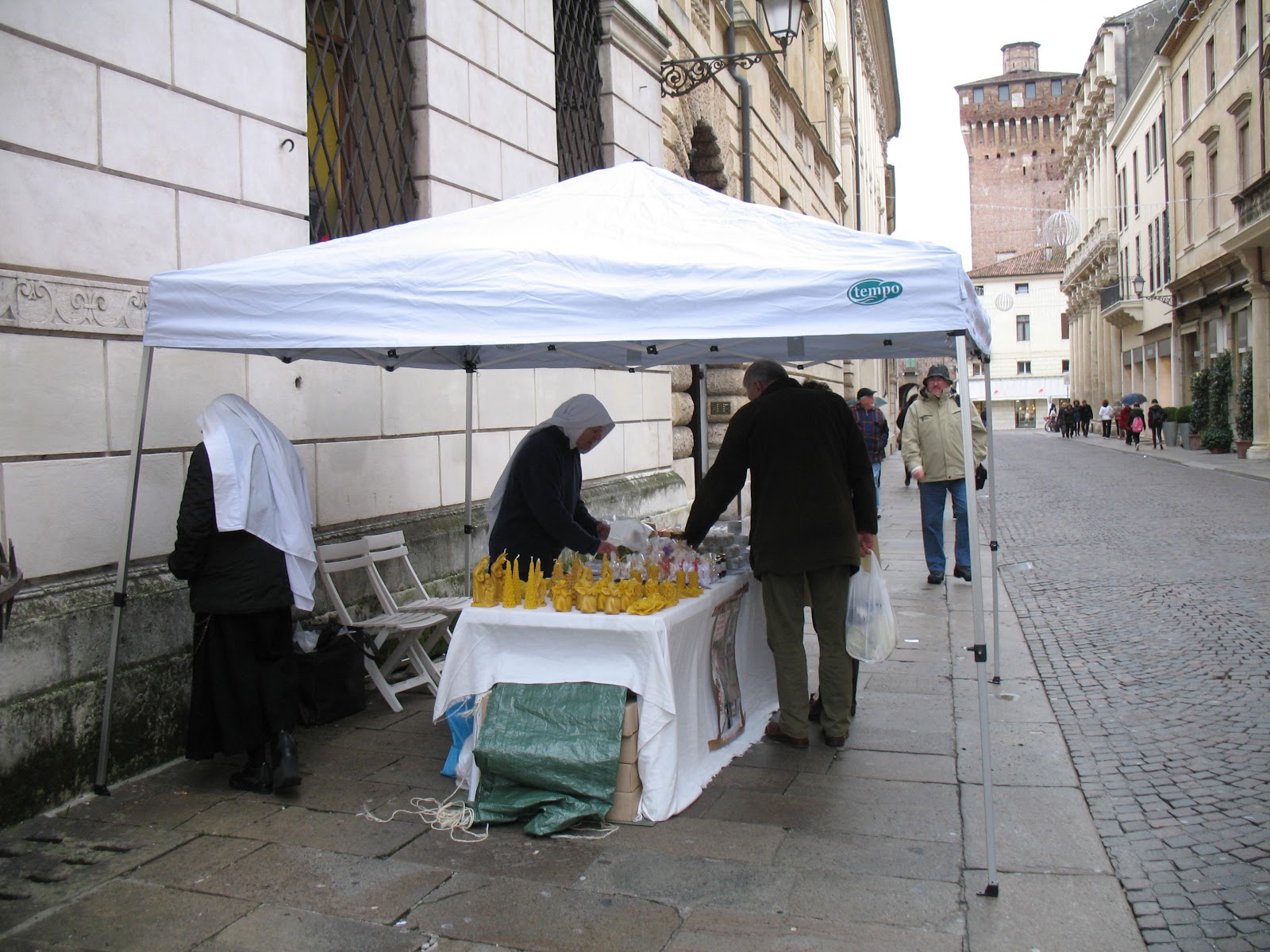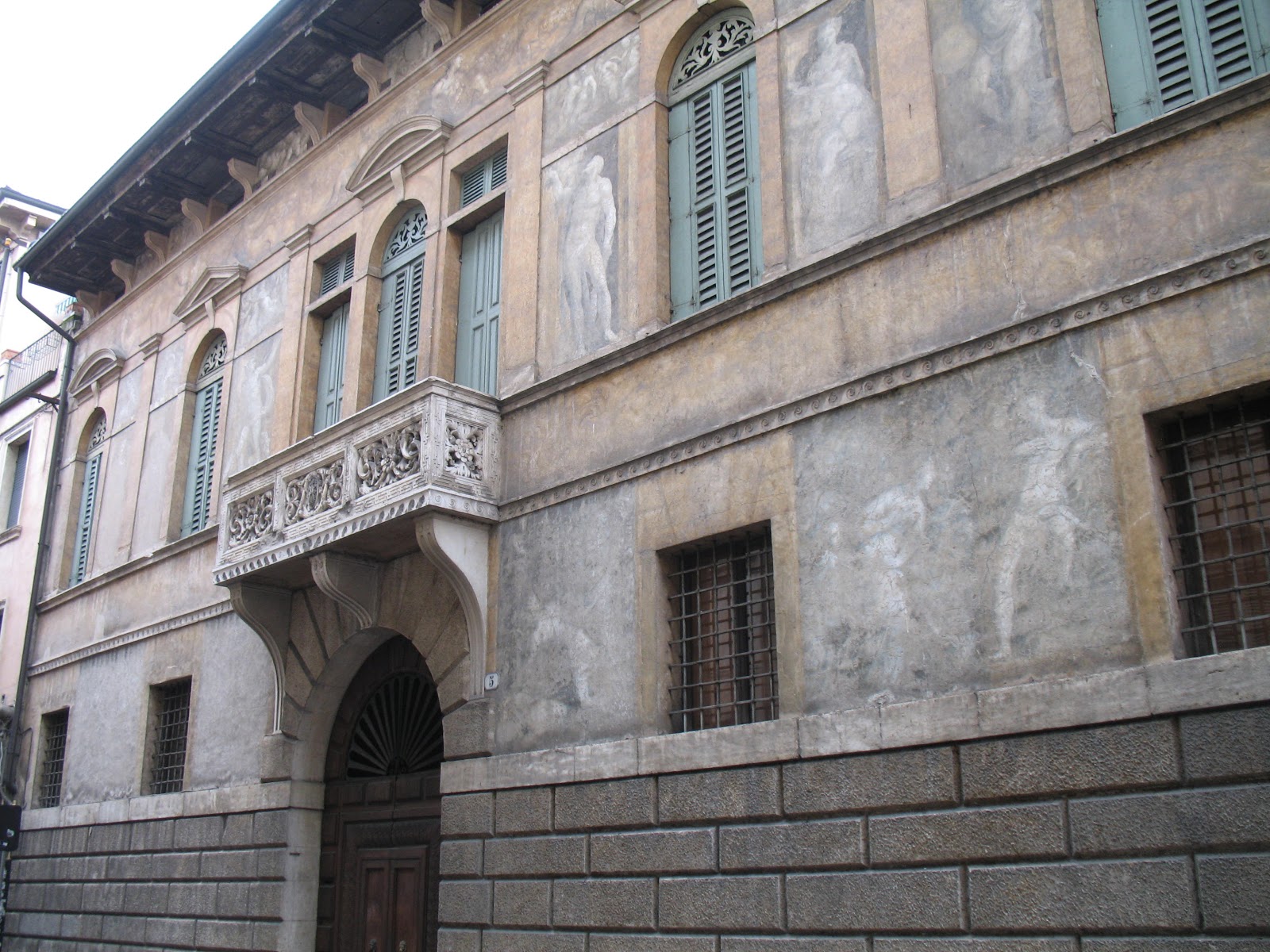After leaving Rome, I had a final week in Italy visiting a few towns in the north to see more art, more buildings and more gardens.
First destination was Mantova where there are some beautiful frescoes by Andrea Mantegna in a room known as the Camera degli Sposi, inside the ducal palace. The ducal palace, a very imposing structure made up of a conglomeration of buildings, is right in the centre of town and impossible to miss.
On the day I was there it was raining so the moat was steadily filling up
and right near the ticket office, I came across this little bit of bad news.
I knew there had been 'seismic events' earlier in the year so, in a way, I wasn't that surprised to find that parts of the palace were off limits. Pity they were the parts I really wanted to see. Still, I went inside and had a good walk around and apart from it being extremely cold (recreating the 15th century a bit too well, I thought) it was an interesting place with lots of other art work scattered about, including walls and walls covered in tapestries designed to look like paintings and paintings designed to look like tapestries, rooms and rooms full of paintings of people all long dead, and rooms and rooms of much less important frescoes like these. Needless to say, photography was not allowed.
Outside, the centre of Mantova is bursting with plenty of other important looking buildings, most of which don't rate a mention on the tourist maps
but which do feature in some of the paintings inside the ducal palace. This one, for example, is directly opposite the palace and is where an earlier family of nobles lived until they were hounded out by the Gonzagas. In fact, the hounding took place in the square right near where those chairs and tables are now set up.
Next stop was Vicenza, home to a number of palaces designed by the most influential of all Western architects, Andrea Palladio. Palladio was the one who resurrected all those classical architectural features with which we are now so familiar: columns,
porticoes,
pilasters (ie, the 'built in' columns),
which he then put into private country villas, city palaces as well as public buildings.
This was Palladio's first major public project, an outer shell on the existing town hall. It took longer than his lifetime to complete.
As you would expect from a great architect, Palladio didn't just copy the classics, he changed things around to create his own particular style. For example, an archway flanked by two rectangular spaces became one of Palladio's most recognisable motifs and is now known as the Palladian arch or Palladian window. Once you notice these details, you start to see them everywhere but it was Palladio who first thought of using them as a distinctive design feature.
Here is another Palladian innovation, his use, on a private palace, of the 'giant order' where the pilasters stretch over both storeys rather than stay within their single upper or lower storeys. This design element had only ever been used on religious or civic buildings, not private homes, until Palladio decided to add it here.
But Vicenza in late November isn't all just Palladio. There are Christmas markets
where you can get local and not so local specialities such as 'tigelle' (bread rolls) from Modena,
vividly coloured liqueurs from the Amalfi coast,
super sized loaves of bread from Puglia,
and even nun-made and nun-sold candles. No doubt the church is desperately in need of the extra funds they raise.
Fair Verona was my final stop in Italy. My main destination was the Giusti garden, originally built in the 16th century, severely damaged by the goodies in WW2 and gradually restored since then. It is breathtakingly beautiful right from the very first step through the gate
and especially so with the final traces of autumn all around.
While the lower garden is a picture of symmetry
and a sea of clipped hedges,
including an apparently simple but surprisingly complicated maze,
the upper garden is all about the views both from below,
and from above.
The palace where the Giusti lived is still standing and still in use but is not open to visitors
unless you happen to need one of these.
The centre of Verona has plenty of other Renaissance palaces, many of which seem to be still in use,
some of which are being very lovingly restored
and some of which are clearly renovators' delights. What an inheritance this one would make!
Downtown Verona was given up to pre-Christmas delights, not all of which were as tasteful as you might think the surrounds would deserve.
And as in Vicenza, the Christmas markets were in full swing
with a distinctly non-religious emphasis on food, specifically sweets of all types, colours and sizes
and 'frittelle' (basically big, sweet, flat doughnuts)
covered in nutella
or, for the particularly adventurous, cream.
Some of the kids have trouble with this stuff. Some can't get their hands or mouths around a piece of sugary pastry that is larger than their head
and some even question whether the brown stuff really is nutella.
Oh to be a dentist in Italy!
Or a photographer ...
First destination was Mantova where there are some beautiful frescoes by Andrea Mantegna in a room known as the Camera degli Sposi, inside the ducal palace. The ducal palace, a very imposing structure made up of a conglomeration of buildings, is right in the centre of town and impossible to miss.
On the day I was there it was raining so the moat was steadily filling up
and right near the ticket office, I came across this little bit of bad news.
I knew there had been 'seismic events' earlier in the year so, in a way, I wasn't that surprised to find that parts of the palace were off limits. Pity they were the parts I really wanted to see. Still, I went inside and had a good walk around and apart from it being extremely cold (recreating the 15th century a bit too well, I thought) it was an interesting place with lots of other art work scattered about, including walls and walls covered in tapestries designed to look like paintings and paintings designed to look like tapestries, rooms and rooms full of paintings of people all long dead, and rooms and rooms of much less important frescoes like these. Needless to say, photography was not allowed.
Outside, the centre of Mantova is bursting with plenty of other important looking buildings, most of which don't rate a mention on the tourist maps
but which do feature in some of the paintings inside the ducal palace. This one, for example, is directly opposite the palace and is where an earlier family of nobles lived until they were hounded out by the Gonzagas. In fact, the hounding took place in the square right near where those chairs and tables are now set up.
Next stop was Vicenza, home to a number of palaces designed by the most influential of all Western architects, Andrea Palladio. Palladio was the one who resurrected all those classical architectural features with which we are now so familiar: columns,
porticoes,
pilasters (ie, the 'built in' columns),
This was Palladio's first major public project, an outer shell on the existing town hall. It took longer than his lifetime to complete.
As you would expect from a great architect, Palladio didn't just copy the classics, he changed things around to create his own particular style. For example, an archway flanked by two rectangular spaces became one of Palladio's most recognisable motifs and is now known as the Palladian arch or Palladian window. Once you notice these details, you start to see them everywhere but it was Palladio who first thought of using them as a distinctive design feature.
Here is another Palladian innovation, his use, on a private palace, of the 'giant order' where the pilasters stretch over both storeys rather than stay within their single upper or lower storeys. This design element had only ever been used on religious or civic buildings, not private homes, until Palladio decided to add it here.
But Vicenza in late November isn't all just Palladio. There are Christmas markets
where you can get local and not so local specialities such as 'tigelle' (bread rolls) from Modena,
vividly coloured liqueurs from the Amalfi coast,
super sized loaves of bread from Puglia,
and even nun-made and nun-sold candles. No doubt the church is desperately in need of the extra funds they raise.
Fair Verona was my final stop in Italy. My main destination was the Giusti garden, originally built in the 16th century, severely damaged by the goodies in WW2 and gradually restored since then. It is breathtakingly beautiful right from the very first step through the gate
and especially so with the final traces of autumn all around.
While the lower garden is a picture of symmetry
and a sea of clipped hedges,
including an apparently simple but surprisingly complicated maze,
the upper garden is all about the views both from below,
and from above.
There are a few things that were considered perfectly normal back in the 1500s but now seem a touch creepy such as this altar built into a cave under the back terrace
and the bizarre faces on some of the fountains.
The palace where the Giusti lived is still standing and still in use but is not open to visitors
unless you happen to need one of these.
The centre of Verona has plenty of other Renaissance palaces, many of which seem to be still in use,
some of which are being very lovingly restored
and some of which are clearly renovators' delights. What an inheritance this one would make!
Downtown Verona was given up to pre-Christmas delights, not all of which were as tasteful as you might think the surrounds would deserve.
And as in Vicenza, the Christmas markets were in full swing
with a distinctly non-religious emphasis on food, specifically sweets of all types, colours and sizes
and 'frittelle' (basically big, sweet, flat doughnuts)
covered in nutella
or, for the particularly adventurous, cream.
 |
| 'New -frittelle with cream' |
Oh to be a dentist in Italy!
Or a photographer ...










































No comments:
Post a Comment